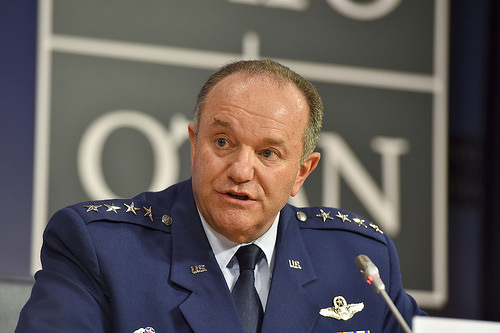 For NATO Supreme Allied Commander Gen. Philip Breedlove, the intelligence coming into his headquarters pointed to a watershed moment for European security, but not everyone wanted to see it that way.
For NATO Supreme Allied Commander Gen. Philip Breedlove, the intelligence coming into his headquarters pointed to a watershed moment for European security, but not everyone wanted to see it that way.
In early 2014, there were signs that Russia was deploying troops to Ukraine’s Crimea Peninsula, abetting local separatists. Yet across the U.S-led NATO alliance, which was drawing down from a long and costly fight in Afghanistan, there was a reluctance to accept that long-held notions about European security were ready to implode.
“It was a tough time, because nations wanted to do the right thing, but also nations needed to be convinced that this wasn’t a legitimate political movement [in Crimea] or a legitimate political action,” said Breedlove, whose three-year tenure as NATO’s supreme allied commander is drawing to an end.
Now, the NATO military alliance has come full circle. Members generally agree that Russia’s intervention in Ukraine demanded action within the alliance, which has since embarked upon its largest transformation since the end of the Cold War….
“He certainly has been the military leader of the alliance at a very historic time, where we’ve had the most dramatic changes since Gen. John Galvin, SACEUR at end of Berlin Wall and Warsaw Pact,” said Jorge Benitez, a NATO expert with the Atlantic Council think tank in Washington. “He also has made comments and raised issues, giving him a higher profile than normally we see from a NATO SACEUR and military commanders.”
From blunt statements about the need to halt troop drawdowns in Europe to pointing out areas of insufficient resources, such as intelligence assets and short supplies of precision munitions, Breedlove has “raised some thorny issues in public,” Benitez said.
Army Lt. Gen. Ben Hodges, who reports to Breedlove as commander of U.S. Army Europe, credited his boss with being a forceful advocate for getting more military resources and explaining the “changed security dynamic” in Europe to leaders back to U.S.”He has been damn good at communicating it in a way that makes sense to civilian leaders,” Hodges said….
On Twitter, in news conferences and before think tanks, Breedlove has been vocal about what he calls a “revanchist Russia,” causing angst in some Western capitals such as Berlin, where leaders have taken a more cautious tack on Moscow.
Earlier this year, the prominent German magazine Der Spiegel, citing concerns of various unnamed NATO and German diplomats, described Breedlove as a “super hawk,” who was exaggerating the Russia threat and the number of forces it was deploying around Ukraine and undermining diplomacy efforts.
Breedlove dismissed criticism that he ever hyped the Russia threat, characterizing his many public statements as an exercise in truth-telling.
Without getting into specifics, Breedlove acknowledged that his military advice has sometimes run counter to the views of his civilian bosses.
“This has happened more than once in my 2 1/2 years,” he said.
He added: “I feel like I am obligated, obligated to tell my bosses my best military advice and what I think right up to the moment they make a decision. When they make a decision, it is my job to support their decision, unless it is immoral or illegal. That’s an easy throwaway. If it is so opposed to my train of thought, I have recourse. I can resign my commission and move on.”
However, to allies in Poland and the Baltics, Breedlove’s willingness to take a hard line on Russia in such a public manner has been a reassuring message of solidarity, experts say.
“He has shown a great deal of skill in managing the different constituencies and walking that fine line,” Benitez said. “You can’t make everyone happy, but he’s shown the skills of alliance management….”
For NATO, Russia’s deployment in Ukraine of hybrid warfare techniques — a mix of unconventional tactics designed to mask direct involvement in a military campaign, such as mobilizing troops without national uniforms — introduced a new dilemma.
“We had to work through the issue of exposing to the world this hybrid warfare, convincing because there were many nations in the West that were unconvinced that Russia was in there,” Breedlove said.
In August 2014, Breedlove’s military headquarters took an unusual step when it released to the public satellite images that it said showed Russian combat forces engaged in military operations in Ukraine. Some of the pictures showed Russian self-propelled artillery units moving in a convoy through the Ukrainian countryside.
“I think that was one of his key moments and showed he is willing to be creative and innovate,” said Benitez, the Atlantic Council expert.
Image: SACEUR Gen. Philip Breedlove, May 21, 2015 (photo: NATO)

